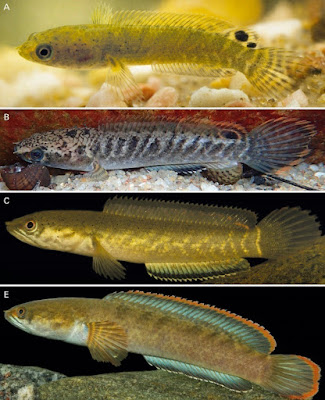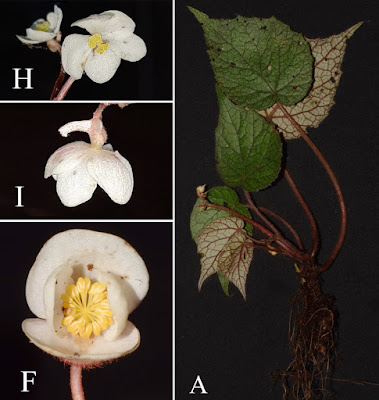[Most Recent Entries] [Calendar View]
Saturday, April 10th, 2021
| Time | Event | ||
| 7:30a | [Ichthyology • 2020] Channa kelaartii • A Valid Species of Dwarf Snakehead (Teleostei: Channidae) from Sri Lanka and southern peninsular India
Abstract The dwarf snakehead Channa gachua (Hamilton, 1822) (type locality Bengal) has been reported from a vast range, from Iran to Taiwan, and northern India to Sri Lanka. Here, adopting an integrative taxonomic approach, we show that the Sri Lankan snakehead previously referred to as C. gachua is in fact a distinct species, for which the name C. kelaartii (Günther, 1861) is available. Widely distributed in streams and ponds throughout Sri Lanka's lowlands, and also recorded here from the east-flowing drainages of southern peninsular India, C. kelaartii is distinguished from all the other species of the C. gachua species group by the combination of head shape, dorsal-and anal-fin ray counts, scale counts, the presence of pelvic fins, and live adult coloration. Further, C. kelaartii is genetically distinct from topotypical C. gachua by an uncorrected pairwise distance of 7.9-8.8 % for the mitochondrial cytochrome c oxidase subunit 1 (cox1) gene. Key words: Channa gachua, integrative taxonomy, DNA barcoding, biogeography, Western Ghats-Sri Lanka biodiversity hotspot. Channa kelaartii (Günther, 1861) Diagnosis. Channa kelaartii is distinguished from the other members of the Gachua group by the following combination of characters: pelvic fin present; lateral head profile pointed anteriorly as in Figure 2A; adults usually possessing 2 – 4, rarely 5 or 6, brown concentric bands in the pectoral fin; 38 –43 lateral-line scales; 5 –½5+1+6½ scales in transverse line on body; 24–28 circumpeduncular scales; 31 –35 dorsal-fin rays; 19 – 23 anal-fin rays; 39 – 42 vertebrae; and live adult coloration as in Figure 3. Habitat, distribution and natural history. Channa kelaartii is a widely distributed fsh in Sri Lanka (Fig. 5B), occurring mostly in lotic waters such as streams and rivers but also in lentic habitats such as pools and ditches in the lowlands. It is usually associated with submerged roots, leaf debris and marginal vegetation during daytime, with adults being solitary or occurring as pairs. During the night, individuals can be more easily observed in open waters. Channa kelaartii and C. orientalis do occur in close proximity in south-western Sri Lanka, where their ranges overlap; they are occasionally encountered in syntopy. Channa kelaartii occurs even in highly modifed habitats such as concretized drains and canals in urban areas. The highest elevation at which we recorded C. kelaartii in Sri Lanka was ca 700 m asl at Lunugala, but Deraniyagala (1929) reported it from Diyatalawa, ca 1200 m asl. Channa kelaartii is not endemic to Sri Lanka and is reported in this study also from east-fowing drainages of southern peninsular India (Fig. 5A). Channa gachua. The type locality of Channa gachua was given by Hamilton (1822) simply as ‘ponds and ditches in Bengal’, a vast area that includes Bangladesh and much of the Indian state of West Bengal (the illustration that accompanied the original description is reproduced in colour in Britz, 2019). .... Hiranya Sudasinghe, Rohan Pethiyagoda, Madhava Meegaskumbura, Kalana Maduwage and Ralf Britz. 2020. Channa kelaartii, A Valid Species of Dwarf Snakehead from Sri Lanka and southern peninsular India (Teleostei: Channidae). Vertebrate Zoology. 70(2); 157-170. DOI: 10.26049/VZ70-2-2020-05 | ||
| 7:33a | [Botany • 2021] Begonia kekarmonyingensis (Begoniaceae, sect. Platycentrum) • A New Species from Arunachal Pradesh, Northeast India
Abstract A new species of Begonia sect. Platycentrum, B. kekarmonyingensis, from Kekar Monying, a place of historical significance in Arunachal Pradesh, Northeast India is illustrated and described. It is allied to B. cathcartii and B. menglianensis, and morphological similarities and differences between the species are discussed. It has been assessed as Vulnerable according to IUCN Red List criteria. Keywords: Conservation status, Indian flora, morphology, rhizomatous begonia, taxonomy, Eudicots Begonia kekarmonyingensis Taram, D.Borah & M.Hughes sp. nov., § Platycentrum Etymology:—Named after Kekar Monying, a place of historical significance and a tourist attraction, from where the type of new species is collected. Distribution and habitat:—Begonia kekarmonyingensis is so far considered endemic to the type locality of Kekar Monying in Arunachal Pradesh (Siang belt). It grows near streams, waterfalls and in rock crevices of the moist shaded areas by the roadside. Momang Taram, Dipankar Borah and Mark Hughes. 2021. Begonia kekarmonyingensis (Begoniaceae), A New Species from Arunachal Pradesh, Northeast India. Phytotaxa. 494(3); 268–272. DOI: 10.11646/phytotaxa.494.3.2 |
| << Previous Day |
2021/04/10 [Calendar] |
Next Day >> |








